#also I’m doing this poll based on the census forms
Explore tagged Tumblr posts
Text


#ren prime#original ren#star wars#star wars sequels#Star Wars comics#aptenotalks#he’s a second gen Brighton beach Slav#or a New Jersey Italian#depends on my mood#also I’m doing this poll based on the census forms#so yay! inclusion
4 notes
·
View notes
Text
Supplementary survey: they/them reflexives, The Sir/Ma’am Issue, and Spivak vs. Elverson
This short, clarifying survey ran from 4th until 24th April 2021. There were 2,998 usable responses. Unlike the annual Gender Census survey, this one was open to anyone of any gender, provided they lived in an English-speaking country.
It asked about two things:
They/them verbs and reflexives - basically whether people who prefer they/them pronouns prefer the reflexive to be themself or themselves, and which people feel is more “correct”.
Sir/ma’am/? - investigating why people use sir/ma’am in areas where it’s polite and common to do so, and whether there are any viable nonbinary or gender-neutral alternatives.
This blog post will also investigate the Spivak vs. Elverson issue, which was actually a separate poll that took place on two social networks.
~
THEY/THEM VERBS AND REFLEXIVES
Someone asked about themself vs. themselves, and it reminded me of some of the they/them issues that people ask about in feedback boxes and various confusions surrounding them.
Singular they - what is it, and when and how do people use it?
Plural they - what is it, and when and how do people use it?
What is the “correct” reflexive for each of these?
You can see the statistics in more detail here, but here’s the graph as an overview:
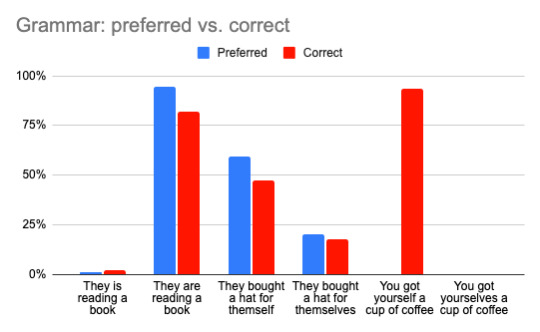
Participants were asked a series of questions about singular they pronouns. Everyone was asked a “which is correct” question, and participants who sometimes or always like to be called ”they” were also asked about their personal preferences.
The graph is a view of only participants who sometimes or always like to be called “they”.
Verbs. As you can see, participants overwhelmingly (94.3%) wanted people to use plural verbs (”they are reading a book”) when talking about them in the third person - even though the percentage of people who thought that was the most “correct” form was a little lower (81.8%). This was lower because 11.4% of participants who preferred “they” answered “both are correct”.
Reflexives. People were much more likely to say that both themself and themselves were correct (28.3%), and more likely to have no preference between the two (17.4%). However, themself was still more popular overall at 59.3%, and 47.3% thought themself was grammatically correct.
You as a control. I also asked all participants whether yourself or yourselves was more correct when addressing one person as a kind of control question, because they is almost grammatically identical to you - it can refer to one person or multiple people, it takes plural verbs even when referring to/addressing one person, and in that situation only the reflexive changes. Many people who say that singular they is grammatically incorrect have no issues with singular you, so it seemed like something that might be interesting to compare. In the graph above you can see that 93.6% of people thought yourself was more correct; only 4.2% of they-accepting participants felt that both yourself and yourselves were equally correct when addressing one person.
There were a couple of things that came up several times in the comments:
“They is” is common in African-American Vernacular English (AAVE), and probably in other dialects too. As I don’t live in the US I’m pretty unfamiliar with this dialect, but either way that seems fine to me. It’s part of why I also asked for participants’ locations, because I wanted others to be able to download the results and see if some regions were more likely to use some words/constructions than others.
There were some alternatives to themself and themselves presented, such as theirself and theirsen. Both of these points lead nicely to the third...
The idea that any language choice is more “correct” than another is quite prescriptive. What feels correct or natural varies depending on a lot of factors, such as where in the world you learned English, and there is no such thing as objective correctness when it comes to such a broad and variable language as English.
I am aware of and agree with that third bullet point, so my asking which phrases were more “correct” was a bit of a trick question. It was a good way to get a feel for people’s linguistic instincts.
I also thought it was interesting that participants who never wanted to be called they were slightly more likely to side with the most popular view on what is “correct” across the board, and less likely to say “both are correct”.
~
PLURAL VS. SINGULAR THEY
I actually ran another version of this survey first and then scrapped the responses, because it was clear that my survey design was leading to some pretty confused and unhelpful data! Among other things, it asked participants whether they preferred singular or plural they for themselves and then directed them to particular questions based on their answer, and the comments suggested that people either didn’t really understand the distinction or meant different things by those terms, even though I had added help text.
This is my understanding:
Singular they is they/them pronouns when used to refer to one person. Verbs are usually plural (i.e. “they are” rather than “they is”), and themself and themselves are both common. Example usage: They are getting themself a cup of coffee. They bought themselves a nice new hat.
Plural they is they/them pronouns when used to refer to two or more people. Verbs are usually plural (i.e. “they are” rather than “they is”), and themselves is almost universal (with the exception of regional variations such as theirselves). Example usage: They are getting themselves some coffee together. They all bought hats for themselves.
Some plural/multiple people refer to themselves as “we” and prefer to be addressed as “they/themselves” (which they call plural they) because they are a group of individuals sharing one body.
The reason I initially asked directly about singular vs. plural they is because I was concerned that plural/multiple systems would cause some statistical confusion. Many plural people have asked me to add plural they to the checkbox list of pronouns in the annual survey, but since it has never been entered by over 1% of participants I have never had reason to do so. As far as I knew, the only difference between singular and plural they is the reflexive (themself for singular and themselves for plural), so I wanted to be able to investigate non-plural people in isolation, and I was curious to know about any trends or differences. I wanted to find out if I should be doing anything differently to ensure that Gender Census statistics are helpful.
So, I swapped out the badly-designed question for a straight-up checkbox, a “check this box if you’re plural/multiple” type of thing, with a note that participants should fill in the survey once per body wherever possible, and then I made some graphs.
Here you can see that plural systems were still more likely to prefer people to use themself to refer to them rather than themselves, though the margin is narrower:
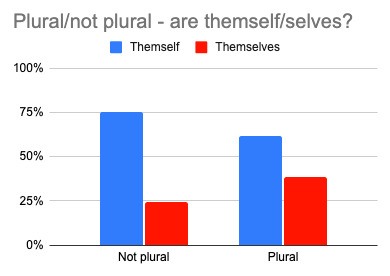
Plural participants were also more likely to say that they sometimes or never want people to refer to them as they, whereas non-plural people were more likely to want people to always refer to them as they (or they just feel fine about it):

There’s not a lot in it, though. It’s all relatively evenly distributed, with no strong leader in either category there.
For the curious: 8.2% of participants checked the plural/multiple box.
In conclusion: plural and non-plural people alike all prefer people to use themself when referring to them in the third person using they/them pronouns, and I feel that there is probably no need to ask about plurality or separate out data from plural people in future. (Asking about this and seeing the responses did in part prompt me to start an anonymous feedback form for plural participants of the Gender Census, though.)
~
THE SIR/MA’AM ISSUE
For several years participants have been asking me in the feedback box of the annual Gender Census survey to also ask about gender-inclusive or nonbinary-specific alternatives to sir and ma’am. I’ve largely not done anything about it, because when informally asking around I’ve generally had the response “just don’t say sir or ma’am, just leave it out altogether.” I live in the UK, where if someone calls you sir/ma’am you’re either looking at home in a fancy restaurant for billionnaires or you’re being made fun of - or sometimes both.
However, during this year’s annual survey while talking about it in a little more depth I learned that there are places in the world where sir/ma’am is very common, required for politeness, and basically inescapable. Nonbinary people in those areas are really struggling, because they do actually need a nonbinary-friendly stand-in for those terms - omitting the sir/ma’am isn’t an option.
Again, the location question was asked so that anyone else downloading the spreadsheet of responses can analyse by region to find out whether sir/ma’am is ubiquitous in particular regions and in which contexts it is used, and can even check whether there is a region-specific alternative to sir/ma’am emerging. I asked several questions about sir/ma’am, including about reasons/contexts and personal preferences, and some superficial analysis is included on the spreadsheet of responses.
But the juicy bit is the nonbinary-specific and gender-inclusive alternative words, right?
[The counting formula is case-sensitive so I made everything lowercase to make the count a little more accurate.]
Suggested gender-inclusive alternatives to sir/ma’am
mx - 4.1% (151)
friend - 2.2%
comrade - 1.2%
captain - 0.7%
ser - 0.5%
mate - 0.4%
m - 0.3%
per - 0.3%
boss - 0.3%
folks - 0.3% (9)
Suggested nonbinary-specific alternatives to sir/ma’am
mx - 8.3% (250)
mix - 0.7%
tiz - 0.5%
friend - 0.4%
ser - 0.4%
comrade - 0.3%
mixter - 0.3%
captain - 0.2%
ind - 0.2%
mir - 0.2% (6)
So it looks like Mx (pronounced “mix” or with a toneless vowel that sounds a bit like “mux”) is the clear winner in both categories. If you want to try to introduce a gender-neutral version of sir/ma’am in your area this one is probably your best bet.
~
SPIVAK VS. ELVERSON
This wasn’t part of the same survey! It was a Twitter poll and a Mastodon poll that ran for one week and ended today, and I’m putting it here because it has to go somewhere.
Sometimes people refer to the ey/em and e/em “versions” of the Spivak pronoun set, which makes my eyebrows do things, because they’re not both Spivak. They are distinct established pronoun sets with their own names.
Spivak - e/em/eir/eirs/emself - written about by Michael Spivak in the 1990s. [source: Nonbinary Wiki]
Elverson - ey/em/eir/eirs/emself - created by Christine M Elverson in the 1970s. [source: Nonbinary Wiki]
The Elverson set is older, but it’s less well-known for some reason, so they’re assumed to be variants of Spivak due to the similarity in spelling.
I was recently asked how we can know which is more popular, given the “oh this checkbox option is close enough, I’ll just choose that instead of typing in my very slightly different set” effect and the “hmm this checkbox option is very close to my set, I’m probably meant to choose this one” effect, plus the boost that checkbox options get with the “oh I hadn’t thought of that one but yeah, why not” effect. Spivak (e/em) is on the checkbox list of pronouns in the annual survey, so it appears to be much more popular than Elverson (ey/em)... but is it really?
I ran a poll on both Twitter and Mastodon, and then used a spreadsheet to extract the useful numbers. There were 141 relevant votes after one week. I wouldn’t usually make annual-survey-altering decisions based on a sample that small, but in this case the results are extremely decisive:
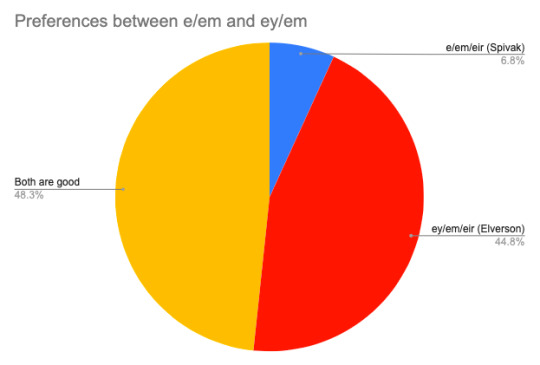
It seems that the highest proportion of people who like at least one of the sets are happy for both to be used, at 48%. 45% prefer ey/em (Elverson) and 7% prefer e/em (Spivak). This is pretty stunning! I’ve been presenting e/em (Spivak) as a checkbox option on the Gender Census annual survey for years, possibly since the first survey in 2013, and because it’s a checkbox option it seems to be consistently a lot more popular than ey/em (Elverson). That’s 4.3% and 0.6% respectively in the 2021 survey. But this poll suggests that actually ey/em (Elverson) is much more popular when the two pronoun sets are viewed on a level playing field.
When you remove all “I don’t mind” votes, you get this:
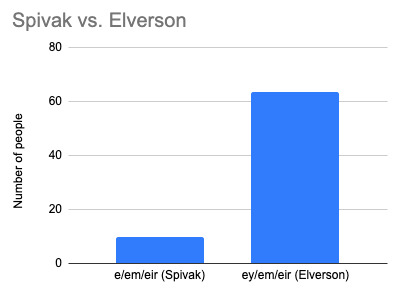
Over 6 times as many people prefered Elverson!
I will definitely be adding Elverson to the Gender Census next year, just so that we can split the e/em and ey/em votes and really get to the bottom of this.
Anyway, while we’re on the topic, ey/em takes singular verbs most of the time.
298 notes
·
View notes
Text
The CCB
There’s little magic left to be found in England, and that which remains is squirreled away into small, secret places and is guarded most jealously. Humans, despite their voracious love for fairy tales, parlour tricks, and boy wizards do not react the best when they come nose to nose with real magic. Real magic, here, is not David Blaine or Copperfield, or even that warm, honey-in-your-gut sensation you get when you see particularly mesmerizing fireworks. Real magic in this case comes in multiple forms, but none of them particularly awe-inspiring. Rather, most of them are beyond terrifying and cause immediate trouser-soiling.
The last magic in the world (and what a peculiarly sad notion that was!), did not come in the form of waving wands, unicorns, or flying carpets, but rather in the daily press and shuffle of the local population. As a certain (and terribly human writer herself) author might say, the _Muggle _population was entirely unaware of what went on just under their noses. This second, secret world was not invisible, but integrated. So used to hiding in plain sight is magic that it has made the daily grind into a costume, into a habit, and most sadly, into a lifestyle.
Would it intrigue you to know just how many creatures, of this world but unknown, shuffle themselves into human form just to pass their days? This magic, magic being a broad, broader, and broadest of terms, is not so much a thing as it is many things. It is, logically speaking, an umbrella term for anything that falls into a human’s definition of something that is non-sensical, defying explanation, or just downright bizarre.
This ideology, however, has caused much debate amongst the Magical community, with many arguing that not everything “non-sensical” is actually magical, and that “bizarre” is not specific enough to fit into the terminology, so really a lot of things considered to be magic are just, well, not.
For instance, many of the older magics insist that Aliens, while definitely bizarre, are not in fact magic, but more of Science. Of course, as with any ethnic argument, this debate hit rather heavily with both the Fresno Nightcrawler community, as well as with the Flatwoods Monster.
“We exist, we’re here,” The Flatwoods Monster, who goes by day by the name of Carol, said in one interview. “To deny us our place in the Umbrella term is to say that we don’t belong. Well, I’ve been here just as long as most of them, if not longer. How can you say I don’t belong? Just because I’m not from this planet, that means I’m not Magic? You have no idea what I was on my planet. None!”
The Fresno Nightcrawlers could not be reached for comment.**
It is tepidly agreed upon by many, that any with access to the CCB (The Creature Control Board), can call themselves magic. The CCB, otherwise known simply as ‘The Board’, has its main building of operation in California. Several smaller, though no less important branches find themselves in Toronto, Ireland, Brussels, Russia, Australia, Peru, and Cairo. There are also outlier stations across the globe, though their google reviews have never risen above 3.5 stars.
The history of the CCB has varied from decade to decade, but it’s purpose has always remained the same. Opened in 1855, it was meant to be a communal hub for the world’s magic. Hot meals were served, advice was given, human visages were constructed, and jobs were allocated. It attracted several thousand in its first month, and subsequently shut a month later due to over-demand. A year later it reopened, armed and ready, and over the years grew into what it is today.
The CCB is now a focal point for the magical community. A community centre, healthcare professional, and Job centre all in one, it is the foundation for all magical life on earth. Magicals come from across the globe seeking guidance or aid, and the CCB delivers. Last year, a total of over 600,000 appointments were made, it is expected that this number will double within the next decade.
Of course, while the vast majority of Magicals are happy to seek out the CCB for aid, there are plenty who are happy to keep themselves separate. Many claim it to be a generational issue, with older Magicals refusing aid or even acknowledging the resource entirely. A poll conducted in 1985 revealed that while 80% of the world’s Magic did indeed use the service, a whopping 20% chose not to. Many of those polled refused to give comment, though a later census revealed that a good number of that fifth were in fact Cairn Creatures.
Cairn Creatures, an unofficial title, are any Magicals born before the approximate date of 1200 CE. They are often assumed to be an offshoot of the Fae world, many having been human in some variation before undergoing magical transmutation. Though they are near extinct in number, these Cairn Creatures walk the line between the mortal world, and that of the Seelie/Unseelie.
It is purported that fewer than one hundred remain in the world, with many of those still residing in either Europe, England, or in Africa.
“It’s a load of p***. This whole classification system is shit. Why would I bother? Are you asking me to join a union? I’m just fine by myself, cheers. Never needed some poxy doctor in a suit to help me mind my own business, ta. Know how to do that myself.” Cat Sidhe, known as Illiver Kash, 1998 CE
One major issue for the CCB has always been management. Prior to its creation in 1855, there was little in the way of policing Magicals. An uncertain set of laws, somewhat akin to Christianity’s Ten Commandments existed amongst the community, though these were treated more as guidelines than as strict policy. So it was in 1859 when the CCB faced its second major hurdle, this time in the instituting of the RRMC. The RRMC, or the _Rules & Regulations for Magical Continuity _was a strict, 6 rule code that each Magical was expected to adhere to. These rules evolved with time, though their core structures have remained the same since their original incarnation. They are as follows:
I. Kill only as necessary; Your survival is based on more than hunger
II. Order first; Adhere to law both Magical and human, for it keeps your secret
III. Purpose in Power; your strength makes you exemplary, but do not forget that you are other
IV. Understand restraint; retribution always comes with a price, if not to you then to your kin
V. Understand Balance; spend your days under guise, the night time is for you
VI. Bond of kin; do no harm to your fellows, for it is the blackest of crimes
As of 2017 CE, the RRMC has evolved into a 260 page manual. This manual has seven key chapters, the first being an introduction, and the latter seven each pertaining to one of the key tenets. Though the original rules remain in place, each now hosts several sub classes and all fall under regulation and moderation policies.
For instance, tenet I, kill only as necessary has been heavily edited, with kill licenses granted to only a select few. These licenses are known most commonly as K-factors, and allow anywhere from one to six human kills a year depending on necessity. At present, less than 25 members of the CCB hold a K6 license.
It is not a stretch to say that these rules were deeply unpopular in their initial years, though as with most policy changes, the community did eventually settle into compliance. There are a few, however, that did not. When the RRMC was put into place, it came with much discussion on the method of dealing with those who did not comply, especially as their sixth tenet explicitly banned the killing of Magicals. In the end it was decided that permissions would be redacted, and sharply, for any who broke the code. In modern times, these permissions would extend to travel permissions, state arrest, and narrowed territories, as well as lessened monetary allowance.
Those that persist despite these allowances are usually allowed ultimatums in the form of banishment. One such case can be traced back to 1976, during the brief trial of Azelgore, known more commonly by humans and other Magicals as the Loch Ness Monster. Though he was initially granted a K6 license, his quota overpassed his allowance by a harrowing degree, and the CCB had no choice but to remove him from his territory. He accepted banishment to the Fae plane, and has since returned only a handful of times on specialised (supervised) allowance.
For most historians working amongst the CCB, its short history is still a colourful one, and one that has markedly improved the lives of most creatures who make use of its services.
2 notes
·
View notes
Text
Weekend Warrior Home Edition – April 3, 2020 – Slay the Dragon, Tape and More
Well, things sure have gone to hell since I last wrote this weekly column that I’ve now been doing in some form or another at one place or other for over nineteen years! For the first time in those 19 years and probably a good 80 or 90 years before that, there were no movies in theaters. In fact, there were no movie theaters. Because of this, the last two weekends have been the first in history with ZERO BOX OFFICE. It’s kind of tough to write a column about the box office and theatrical releases when there are none, n’est ce pas?
So I’m going to try to evolve for the time being, and we’ll see how that goes. I’m not too thrilled about having to watch movies as screeners, let alone writing about movies that will probably never get a theatrical release, but I’ll try to make the best of it. (Oh, and Disney’s Onward, which opened in theaters less than a month ago will be available ON DISNEY+* tomorrow.) (*corrected)

This week’s “Featured Movie” that you absolutely must see, especially if you’re reading this from one of the “red states” and feel like government just isn’t doing things the way you’d like them to do, is Barak Goodman and Chris Durrance’s political documentary SLAY THE DRAGON (Magnolia). It covers how gerrymandering is being used in census years (like this one) to maintain a Republican majority in local and state government. Goodman’s doc begins in Michael Moore territory of Flint, Michigan and shows how gerrymandering was used to create a Republican majority that led to the town getting water from the nearby Flint River which contaminated the pipes and leaked lead into the system.
The film does a good job explaining gerrymandering in an easy to understand way by following a few specific cases of people fighting against the policies. Counties and voting districts in different states aren’t just a straight grid on a map. Instead, the districts are drawn up to cause an unfair advantage to a party. This was especially true of the REDMAP program instituted in 2008 by the GOP after Barack Obama was elected President to make sure Republicans could dominate Congress as well as politics on a state level.
Much of the film deals with Katie Fahey’s group Citizens United that has decided to take on the politicians with its grassroots campaign to allow the people’s voices and votes to start counting. (One of the programs that grew out of REDMAPping was that thousands of voters were not able to vote since a few states passed a law that ID was required to vote, thereby keeping black and brown voters from the polls.)
Yes, it’s a rather complicated situation but it’s one that people in the primarily liberal states like New York, California and others really need to know about, since it’s why we have a reality TV host as our President right now as well as why we have a Republican Senate that just prevented him from being impeached. All of the bigger politics goes back to the individual state politics and how gerrymandering and REDMAP unfairly sways the vote against those who win on the state level in census years (essentially every ten years including 2020). Originally, this was going to get a theatrical release in March but now it will only be available on digital and On Demand, so you can find out how to see it on the official site.
I also want to give a little extra attention to Deborah Kampmeier’s TAPE (Full Moon Films), which skipped its theatrical release instead to do an interesting “virtual theatrical run,” playing every night On Demand via CrowdCast. It’s available every night at 7pm eastern followed by discussions with the filmmakers and then will be on Digital and VOD on April 10. Again, these are changing times, but this is a haunting and powerful thriller based on true events, starring Anarosa Mudd as a woman trying to catch a sleezy casting agent (Tarek Bishara) who is preying on actresses and one in particular, played by Isabelle Fuhrman (Orphan). Both of their performances are pretty amazing, Mudd playing a shaven-head whistleblower and Fuhrman playing an ambitious young actress who think she’s finally gotten her much-needed break, but finding out there’s a lot darker side to the business than she expected. While a lot of people have raved about The Assistant as a response to #MeToo, this is a much starker and direct look at the abuse of power to take advantage of young women. The movie is not going to be for everybody, because it takes some time before you realize what Mudd’s character (who could just as easily be Rose MacGowan) is up to, but the way how things play out in the film makes it unforgettable. It’s a fantastic new movie from Kampmeier, who famously had an underage Dakota Fanning have a rape scene in her earlier movie, Hounddog.
A movie that was released last week that I didn’t get to write about (but it’s still available On Demand and Digitally, as many movies currently are) is Lorcan Finnegan’s VIVARIUM (Saban Films), starring Jesse Eisenberg and Imogen Poots. It’s a virtual two-hander in which they play a couple who look at a house in a suburban housing complex where every house looks the same. They soon learn that they can’t escape and things get weirder and weirder from there. I can’t say I loved the movie, because it just got weirder and weirder, almost to a fault at times.
Polish filmmaker Malgorzata Szumowska’s THE OTHER LAMB (IFC Midnight) is another movie about a religious cult, this one a group of women that live in a remote forest commune led by a man they call “Shepherd” (played by Michiel Huisman from Game of Thrones and The Haunting of Hill House). It follows a teenager named Selah (Raffey Cassidy) who begins to question her existence when she starts having nightmarish visions. This was okay, but I really have hit my limit in terms of movies about religious cults. They’ve just been overdone.
Mike Doyle’s rom-com ALMOST LOVE (Vertical) is about a group of middle-aged friends trying to navigate love and relationships with a cast that includes Scott Evans, Kate Walsh, Patricia Clarkson, Augustus Prew and more. Some of the characters are having marital issues, others are dating or getting into early feelings of possible love. It’s a nice distraction from all the serious stuff going on in the world today.
A great music doc now On Demand, digital and other formats (Blu-ray/DVD) is Brent Wilson’s STREETLIGHT HARMONIES (Gravitas), which takes a look at the early doo-wop vocal groups of the ‘50s and ‘60s that predated and formed the basis for Rock & Roll, Rhythm & Blues and other music genres as we know them today. It deals with acts like The Drifters, Little Antony and the Imperials, The Platters, and Frankie Lymon and the Teenagers. It includes interviews with some of the more recent acts influenced by it including En Vogue and N’Sync as well as Brians Wilson and McKnight. I was surprised by how much I enjoyed this despite doo-wop not being my preferred music style. (For the sake of transparency, I helped out with a little bit of publicity on this film.)
Also, Olivier Meyrou’s fly-on-the-wall doc Celebration (1091) is a movie that was commissioned by Yves Saint Laurent’s former lover and business partner, Pierre Bergé, more than ten years ago but was shelved for being too revealing. It was filmed over the course of three years where Laurent was at his most frail and mostly separated from the world as we get a look inside one of the last great haute couture houses. It’s now available On Demand and digitally.
Jon Abrahams directs and co-stars in Clover (Freestyle Digital Media) opposite the great Mark Webber, playing bumbling Irish twins trying to pay off their father’s debt to local mob boss Tony Davolo, played by Chazz Palminteri. Things get more complicated when a teen girl named Clover (Nicole Elizabeth Berger) shows up and the brothers need to protect her from Tony’s “hit-women.” Looks like a fun dark comedy.
Unfortunately, Saban Films didn’t offer advance review screeners of the action sequel, Rogue Warrior: The Hunt (Saban Films), directed by Mike Gunther, but it stars Will Yun Lee. I’m not sure if this is a sequel to 2017’s Rogue Warrior: The Hunt, but I haven’t seen that either. It involves the leader of an elite team of soldiers being captured by terrorists, so his team needs rescue him. Oh, and Stephen Lang (Avatar, Don’t Breathe) is in it, too.
STREAMING AND CABLE
This week’s Netflix offerings include the streaming network’s latest true-crime documentary series, HOW TO FIX A DRUG SCANDAL, directed by Erin Lee Carr (Dirty Money), which covers the 2013 case of Sonja Farak, a crime drug lab specialist who was arrested for tampering with evidence but also accused of using the drugs she was supposed to be testing. (It’s on the service as of this writing.)
Stuber and Good director Michael Dowse helms the action-comedy COFFEE & KAREEM, starring Ed Helms as police officer James Coffee, who begins dating Taraji P. Henson’s Vanessa Manning while her 12-year-old son Kareem (Terrence Little Gardenhigh) plots their break-up. Kareem hires criminal fugitives to kill Coffee but instead ends up getting his whole family targeted, so the two must team up. Also starring Betty Gilpin, RonReaco Lee, Andrew Bachelor and David Alan Grier.
Also on Friday, Disney Plus will stream two Disneynature docs, Dolphin Reef and Elephant, in honor of Earth Day taking place later this month. Previously, one or both of these movies might have been released theatrically but hey, earth is going to hell right now.
Now playing on Hulu is the latest installment of Blumhouse’s “Into the Dark,” Alejandro Brugué’s Pooka Lives, which ties in with “Pooka Day” (no idea what that is) but apparently, Pooka is a fictional creature like “Slender Man” that was created on Creepypasta by a group of friends that goes viral but then manifests into creatures that become real. It stars fan faves Felicia Day, Will Wheaton, Rachel Bloom and more.
Next week, more movies not in theaters!
By the way, if you read this week’s column and have read this far down, feel free to drop me some thoughts at Edward dot Douglas at Gmail dot Com or send me a note on Twitter. I love hearing from readers!
#Movies#Reviews#TheWeekendWarrior SlayTheDragon Streaming VOD#TheWeekendWarrior#Vivarium#SlayTheDragon#Streaming#VOD
0 notes
Text
What's the post-Trump reform agenda?
Not sure if anyone noticed, but I've been neglecting this blog lately. Too many fish in the barrel, not enough bullets. And others doing it much better, which is a good thing.
But I’m surprised there isn’t much discussion (that I’ve seen) on the post-Trump reform agenda. We could need one sooner than we think - or later than we fear. In any case, here’s my two cents. This list focuses on institutional/structural changes - hopefully these are acceptable to people of all ideological stripes who are interested in strengthening democratic self-government rather than narrow partisan interests. Many will need constitutional amendments, and some are more realistic than others. But we have to start somewhere.
Prosecutors and judges
1. The Attorney General becomes a non-political, non-partisan post. Yeah, you can still have a “Secretary of Justice” or whatever for policy issues, but prosecutions under federal law should be independent from political influence. Have the AG serve one, nonrenewable 10 year term, appointed by the president and confirmed by the Senate, but cannot be removed except for gross incompetence/malfeasance. FBI reports to the AG.
2. AG appoints US attorneys for fixed, staggered terms, say 6-8 years. Again, cannot be removed without cause. AG can choose to appoint special prosecutors for special cases.
3. All written and verbal communications by officials in the executive or legislative branch with the AG, other federal prosecutors or the FBI are matters of public record.
4. Federal district and appellate judges serve for fixed terms, say 12 years. Supreme Court justices maybe 16 years.
Campaign finance
5. Sources and amounts of all donations to political candidates, causes or organizations greater than $1000 in a calendar year are matters of public record. This applies to any donation, in cash or kind, to anyone who seeks public office, and to any person or organization that communicates against others seeking public office, or advocates on an issue that is currently subject to political debate
The president
6. The president becomes fully subject to executive branch ethics rules.
7. The president must release complete financial info, including tax returns, assets and debts, and eliminate any financial conflicts of interest and all foreign sources of income by the time of his/her inauguration. If s/he fails to do so, this automatically triggers impeachment proceedings.
8. If the president is impeached and removed from office, the vice president serves in a caretaker role until new elections are held, no later than six months after the president leaves office.
The Senate
9. No more Senate filibuster. However, all matters of substance in the Senate must be approved by a majority of senators and by a majority of population represented by those senators as measured at the most recent census. A bill would become law if it passes the House by a majority, and both tallies in the Senate. Kamala Harris would have 37 million votes, Mike Rounds of South Dakota would have 814,000. Right-wingers will be happy to learn that Ted Cruz gets 25 million votes.
10. Senate vacancies are filled by prompt special elections, not gubernatorial appointment (this always bothered me).
Elections
11. No more electoral college. President chosen by nationwide popular vote.
12. No more party primaries, at any level. All elections have two rounds: if no one gets more than 50% in the first round, the top two candidates compete in the second. This would be a big culture shock at the presidential level, but I think we could make it work.
13. Congressional and state-legislative district lines to be set by independent commissions with equal representation of both major parties and representation by minor parties. Agreement of reps of both major parties on these commissions needed for final approval, and districts must meet broad federal guidelines (contiguity, racial balance etc).
14. You want voter ID? OK, anyone who shows up at a polling place (which opens two weeks before election day) with a valid photo ID that proves citizenship can vote and is automatically registered for the next eight years. So no chance for voter fraud (which is virtually nonexistent anyway) and no more convoluted requirements for advance registration. You can get a special voter ID based on address-based forms of identification (birth certificate + bank statement etc) from your local DMV or elections office, without a fee, up to two weeks before the election, also valid for 8 years.
15. Ballots are mailed to all registered voters four weeks before the election. Completed ballots can be mailed in or dropped off at a polling place at any time thereafter.
16. For those who wish to vote in person, voting machines must meet strict security and transparency guidelines, including published software and an auditable paper trail.
17. Every election will automatically be audited (ie a sample of precincts/counties will have their votes hand-counted); any irregularities will trigger a broader recount.
18. A county where officials are found to have harassed, intimidated or otherwise restricted voters will have its elections federally administered for the next ten years. A state that has three or more such counties will have all of its elections federally administered for the next ten years.
Miscellaneous
19. No more penny. WTF is worth two cents?
20. You want to sell health insurance across state lines? OK, health insurance can be sold across state lines, but the health insurance industry is now regulated at the federal rather than the state level. Actually all insurance should be regulated at the federal level.
21. No more debt limit. Come on, it’s a stupid idea.
22. If the appropriations bill for an authorized federal agency or department is not passed by the end of the fiscal year, the previous year’s appropriation is automatically renewed, with an inflation adjustment. So no more government shutdowns.
23. Members of Congress can be prosecuted for insider trading based on knowledge they acquire as part of their legislative activities.
24. The District of Columbia gets either the senators and representatives it would be entitled to if it were a state, or statehood.
25. Puerto Rico gets either statehood or (once its finances are straightened out) independence.
26. Civics classes made mandatory in all schools, public or private. These will cover how the government works, how citizenship works, how to critically read news coverage, how to judge the reliability of news sources, how to engage in public debate, and how to distinguish facts from opinions.
Anyway, that’s my agenda. What’s yours?
#politics#trump#donald trump#republicans#democrats#senate#congress#u.s. congress#u.s. elections#elections#district of columbia#puerto rico#debt ceiling#government shutdown#attorney general#fbi#Federal Bureau of Investigation#u.s. attorney#u.s. attorney general#filibuster#impeachment#vice president#voting rites#voter rites#voter suppression#voter id
48 notes
·
View notes
Text
Week 4
Another week, another blog!

This week we’re going to be talking about public opinion and how audience is measured, when I think about measuring audiences my first thought is the census that basically collects all your data but as we learnt some problems come with the public opinion. In the beginning, there was the ‘bourgeois of the public sphere’ which was spaces where individuals came together to essentially, talk, this could mean places like salons, coffeehouses. It was in the 16th century that the printing press made way for the public sphere and gave the people a voice in the public, the press “made publics by opening up the affairs of state to citizens who had no other way of knowing” (Sullivan, p. 60) by doing this they gave the public an opinion and the public is important because it brought people with the same values together. I would say the idea of the public sphere has changed over the past few centuries and there are multiple ideas of what or where a public sphere is. For me just sitting in a seminar is an example of a public sphere because it's a group of people coming together to discuss their opinions on a certain topic.
Plato argued that there were 2 types of thinking Doxa and Episteme, Doxa refers to an opinion that is fickle and changing and Episteme is knowledge that can be informed by scientific fact. Plato way of thinking argued that the public had the powers to make decisions based on doxa but he doubted that the common people had the wisdom (episteme) to make the right decisions. Keeping these 2 ideas in mind I wanted to talk about ‘The Central Park Five’ as I just watched it on Netflix and is based on true events; an assault and rape case that happened in 1989.
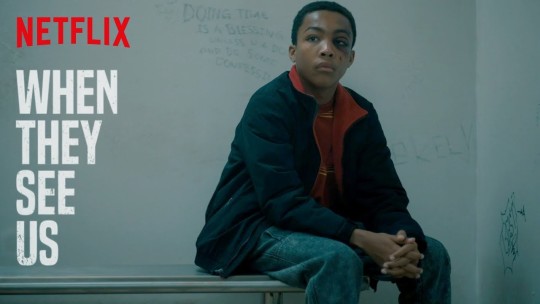
The Doxa and the public opinion when it came to this case and the trial about these 5 boys were highly regarding their race, 4 out of the 5 boys were African American and the other Hispanic American and the victim was a white woman which drastically changed the public opinion during the trials. The public opinion was further pushed negatively when Donald Trump came into the picture and wrote how the Central Park Five were guilty and should not have been freed.
The Episteme of this case is that the victim was assaulted and raped in Central Park, the confessions of the boys came after rough police investigations, none of the DNA found at the crime scene matched any of the boys, Matias Reyes a convicted rapist confessed to the crime and his DNA was found at the scene. This goes to show that despite the episteme and having scientific evidence that proved the 5 boys were innocent, the majority of the public opinion stayed the same. (BBC, 2019)
Neubaum and Krämer’s article ‘What Do We Fear? Expected Sanctions for Expressing Minority Opinions in Offline and Online Communication’ discusses their research on how situational factors can influence an individuals’ ability to express their viewpoints if their opinion is in the minority (Neubaum & Krämer, 2018). We can look at this in relation to the Central Park Five as some people might have felt uncomfortable with voicing their true opinions about the case if they were surrounded by individuals who believed that they were guilty.
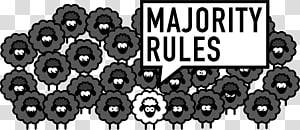
Neubaum & Krämer also discuss the spiral of silence which is the idea that individuals are social beings who ultimately want to fit in, and we use the media to tell us what to think and are hesitant to voice opinions if it does not match the majority of the public. Through their research Neubaum and Krämer found that the fear of being personally attacked is one reason why people are more willing to voice opinions offline rather than online, and they also discovered that users commonly have a following of a certain criteria and are likely to hold back their opinion if they feel like they would lose their audience. Which takes us back to why opinion polling can be wrong and lead to false data, not everyone is willing, to be honest in their opinions if it is in the minority or if they have something to lose (Neubaum & Krämer, 2018).
Moving back in time, in the 19th century, public opinion was quantified and it changed the idea of what it meant was meant by ‘public,’ the rise of quantification meant that the public was the “majority as measured by numerical counts” (Sullivan, p. 61). Straw polls are the quantitative form of opinion polling and they consist of a survey in which the popularity of something is recognized. As discussed in lecture, Sullivan argues that there is power in voting as it gives people opinion and a choice but the idea of random sampling sends the power shift back down because it means turning people in numbers. (Sullivan, p. 63).

I read an article published in The Guardian this week, that said ‘the polling industry doesn’t measure public opinion but produces it.’ The article goes on to discuss how in 1947 researcher tested the American public opinion on the ‘Metallic Metals Act,’ which I’m sorry to say was not a real thing. However, the research found that 70% of respondents took a strong position for or against even without knowing what they were voting for. Researchers found that most of the time individuals make decisions based on the conditions that they’re in, being under pressure to have a specific opinion on something can lead to false choices. Interviews or surveys do not have the same real-life conditions in which public opinions are made, but they design and produce quantifiable opinions (The Guardian, 2019). Which is similar to political polling; people can say that they’re voting for a specific party based on who is asking, the people around them, the amount of knowledge they have but all of this can change when it’s time to actually vote.
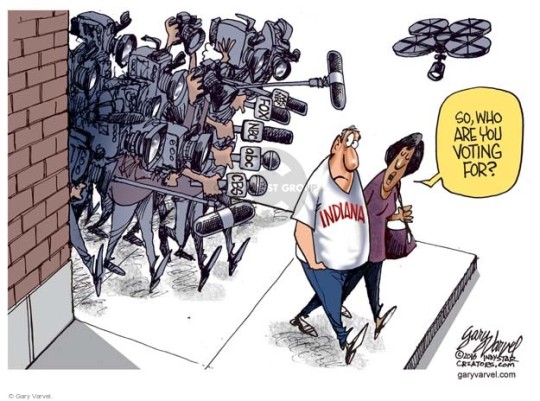
See ya next week!
0 notes
Link
Democrats have a problem. Most Americans agree with their economic stances but they have been unable to translate this fact into policy and electoral outcomes.
As an example, for almost two decades, respondents to Gallup polls have said that providing health coverage to everyone was a “responsibility” of the federal government. Similar majorities have long existed for increasing taxes on the wealthy, regulating businesses and financial markets more tightly, and pretty much every other domestic policy issue favored by the party’s left wing.
Some on the left have blamed Democrats’ electoral dysfunction on ever more sophisticated forms of gerrymandering, and indeed Republican-led redistricting in several states after the 2010 census has helped lock in a GOP House majority. But that does not explain why Republicans have won a majority of U.S. Senate elections since the mid-1990s, or the fact that they consistently do much better in the state-by-state vote, in presidential elections, than in the national popular vote.
In 2016, Donald Trump carried 30 states, while losing the popular vote to Hillary Clinton by more than 2.5 million. In 2012, despite losing the popular vote by almost 4 percentage points, Mitt Romney actually won 24 of the 50 states. In 2008, John McCain managed to carry 22 states, even though he lost the popular vote by a landslide, finishing nearly 10 million votes behind Barack Obama. In the 2004 presidential election, George W. Bush narrowly won the national popular vote — the only time a Republican has done that since 1988 — but he won 31 states in the Electoral College.
Democrats’ current fortunes in this regard are a striking reversal of the party’s situation during the 1970s and 80s. In those decades, the party had great difficulty winning the presidency, but tended to dominate congressional races.
One way of understanding this turnabout for both Republicans and Democrats at the presidential and congressional levels is by considering the changing issue climate facing the parties over those decades. During the latter years of the Cold War, Americans often trusted Republican presidents like Richard Nixon and Ronald Reagan to check the power of the Soviet Union. At the same time, however, the legacy of Franklin D. Roosevelt’s New Deal and Lyndon B. Johnson’s Great Society, meant that many people trusted Democrats to handle domestic issues in Congress.
With the end of the Cold War and George W. Bush’s disastrous war in Iraq, Republicans lost their advantage on foreign policy. But instead of becoming the majority party at every level — as they were in the middle of the 20th century — Democrats have been continually stymied in state and local elections, reportedly losing more than 1,000 legislative seats in non-coastal states during the Obama years. This is partly due to the ongoing segmentation of the country — what many demographers call The Great Sort — into urban areas that are culturally liberal and vote Democratic and rural and exurban areas that support Republicans’ cultural conservatism.
This divide isn’t anything new; people who live in cities have historically been more liberal. What’s changed is that both parties have become more ideologically homogeneous on cultural issues. In the past, the Democratic Party was a broad coalition that housed labor-union socialists and civil rights activists alongside ardent Southern segregationists and anti-communist Cold Warriors.
After the end of the Cold War and the collapse of the Soviet Union — which reordered the global map and drove socialism to the ideological margins, at least temporarily — Democrats reoriented themselves on economics, largely at the instigation of “New Democrats” like former President Bill Clinton. This strategy worked for the party at the presidential level; as noted above, Democrats have won the popular vote in six of the last seven elections. But it has been a dismal failure at the state and local level, for a simple but subtle reason: There are more people in total who hold liberal or progressive views on issues like LGBT rights, race relations, abortion and immigration — but that majority is clustered into relatively compact areas, largely in the Northeast Corridor and on the Pacific Coast.
To break that down a little: In 2012, according to demographer Richard Florida, Mitt Romney won a total of 214 metropolitan areas. Barack Obama carried a significantly smaller number of metro areas, just 150 — but the ones he carried were far more populous. The average Obama area was home to more than 1 million people, while the average Romney area was home to just over 400,000.
Put simply, more people agreed with Democrats but Republicans are more efficiently distributed, from a purely political standpoint.
* * *
Democratic officials at the national level seem to have been presented with at least some of these data points. On Monday, Senate Minority Leader Chuck Schumer flat-out stated that he believed it was time to refocus the party’s agenda during a news conference to roll out a new Democratic agenda called “A Better Deal.” While Republicans (and some leftists) have mocked the idea, comparing it to a Papa John’s Pizza slogan, Democratic officials say the agenda was formulated after months of polling and electoral analysis.
“The focus starts on economic issues,” Schumer said. “There is not that divide on economic issues.”
He continued: “That’s where the American people are hurting. That’s what we most felt was missing in the past in the last several elections.”
In an interview with Politico, Sen. Chris Van Hollen of Maryland, head of the Democratic Senatorial Campaign Committee, said that party leaders had reached an “overwhelming consensus” on the agenda items of creating more better-paying jobs, lowering health care costs and pushing back against businesses through fighting mergers and fees. According to Schumer, even Sen. Bernie Sanders — the Vermont independent who has been a persistent thorn in the side of Democratic officials he sees as too cautious and too conservative — was consulted extensively.
“What we’ve tried to do here is choose things that just about every Democrat can support but that really resonates with the American people,” Schumer said at the Monday press conference. “And a lot of them are things Bernie Sanders campaigned on.”
While liberals have faulted the party’s new agenda for being too small-bore, Schumer, House Minority Leader Nancy Pelosi and other Democratic leaders say they plan to add more items to the “Better Deal” agenda. In a Sunday interview with ABC’s “This Week,” Schumer said that expanding government health care programs is under consideration as well.
“Many things are on the table. Medicare for people above 55 is on the table. A buy-in to Medicare is on the table. A buy-in to Medicaid is on the table,” Schumer said.
“Week after week, month after month, we’re going to roll out specific pieces here, that are quite different than the Democratic Party you heard in the past. We were too cautious. We were too namby-pamby,” Schumer added.
The new agenda earned some praise from Rep. Tim Ryan, an Ohio Democrat who represents the blue-collar area surrounding Youngstown, which Trump visited Tuesday evening to try and rally his supporters.
“I think it’s a good step in the right direction, focusing on the economy, jobs and wages,” Ryan said in an interview with Salon. “In addition, we need to talk about some of the values that are behind these policies — that if you work hard and play by the rules, you can get ahead in a democratic country.”
That praise is notable because Ryan is one of several Democratic members of Congress who have sought to depose Nancy Pelosi from her longtime post as party leader in the House of Representatives.
According to Ryan, in last year’s presidential campaign Trump managed to steal Democrats’ thunder by copying their rhetoric on protecting jobs and keeping a level playing field for people who follow society’s rules.
“What’s an America 2.0 going to look like, what’s a Democratic Party 2.0 going to look like?” Ryan asked. “We need to start organizing around that in a big way — in contrast to Trump who’s trying to take us back to coal mines and steel mills that he said he was going to reopen. He can’t do any of that, but we have to present our own plan.”
Refocusing the Democratic Party onto economic issues has also been a big concern for Rep. Pramila Jayapal, a congresswoman from Washington state who has become a rising star on the party’s leftward side.
“I think part of the problem is that we have narrowed the voting base more and more,” Jayapal told Salon. “In doing that, we’ve been kind of catering to a smaller set of voters each time, while also simultaneously making the differences between the two parties even smaller as well.”
According to Jayapal, progressives have placed too much emphasis on a larger sense of political identity, instead of on political issues themselves.
“A lot of voters are not inspired. They don’t feel like they’re voting for someone who represents their values,” she said. “Even though I’m a progressive and I talk about progressives across the country, I think a lot of the issues that we’re fighting for are not ‘progressive,’ they’re just right for working people.” She cited higher minimum wages, domestic-oriented trade policies and free college tuition as examples of policies that anyone could support, regardless of where they think they fall on the political spectrum.
The way forward for Democrats, Jayapal says, is for the party to focus not just on getting loyal Democrats to vote, but also to encourage Americans who feel isolated from political elites. Beyond emphasizing more populist economics, she argues that Democrats also need to abandon a one-size-fits-all approach to political rhetoric.
“I’ve never liked the false choice between ‘identity politics’ and economics because I think that race, class and gender are deeply intertwined,” she said. “But I think different groups of people respond to those issues in different ways, so there’s no single way to talk to everybody. What you do, though, is that once you’ve won their trust on one piece, you can draw the dots to the other two.”
Time will tell just how committed Democrats are to this rebranding campaign. But they appear open to the idea that while President Trump himself is deplorable, many of the people who voted for him aren’t, an idea Sanders emphasized in a speech this past April.
“Some people think the people who voted for Trump are racists, sexists and homophobes, just deplorable folks,” he said at the time. “I don’t agree, because I’ve been there.”
The way to solve the problem, Sanders told a Boston crowd, is to restructure the Democratic Party to orient itself away from the billionaires, celebrities and Wall Street types who have dominated its donor class and driven its issue positions in recent decades.
“We need a Democratic Party which is not the party of the liberal elite but a party of the working class of this country,” Sanders said. “We need a party that is a grassroots party, a party where candidates are talking to working people.”
Some social-justice progressives will undoubtedly raise concerns about the party’s apparent shift toward a more economically-oriented message. One response to this is the argument that while the religious right keeps on fighting the culture war, in terms of overall public opinion that conflict ended some time ago. Poll after poll has demonstrated that most Americans want to keep abortion legal, support marriage equality and oppose discrimination under the guise of religious freedom.
Those issues may still be able to motivate the GOP’s base of aging voters, but they are a declining regional minority within the American population, including among young Republicans.
In 2014, before the Obergefell vs. Hodges Supreme Court case, a Pew Research Center survey found that over 60 percent of self-identified Republicans between the ages of 18 and 29 supported same-sex marriage. On immigration, a survey conducted by PRRI released this month found that 62 percent of young Republicans support a path to citizenship for illegal immigrants. Even on the much newer issue of transgender rights, multiple congressional Republicans just yesterday publicly broke with the president’s ban on transgender military service.
via Salon: in-depth news, politics, business, technology & culture Salon
0 notes